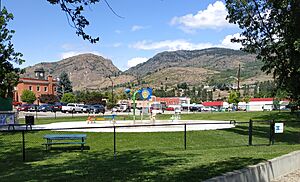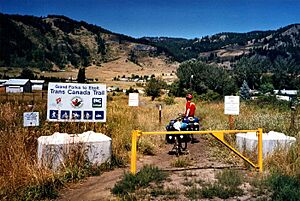Grand Forks, British Columbia facts for kids
Quick facts for kids
Grand Forks
|
|
|---|---|
| City of Grand Forks | |
 |
|
| Motto(s): | |
| Country | Canada |
| Province | British Columbia |
| Region | Boundary Country |
| Regional district | Kootenay Boundary |
| Incorporated | 4 March 1897 |
| Government | |
| • Type | Mayor–council government |
| Area | |
| • Land | 10.37 km2 (4.00 sq mi) |
| Elevation | 520 m (1,710 ft) |
| Population
(2021)
|
|
| • Total | 4,112 |
| • Density | 396.4/km2 (1,027/sq mi) |
| Time zone | UTC−08:00 (PST) |
| • Summer (DST) | UTC−07:00 (PDT) |
| Postal codes |
V0H 1H0 & V0H 3H0
|
| Area code(s) | 250, 778, 236, 672 |
Grand Forks is a city in the Boundary Country area of British Columbia, Canada. It's found where the Granby and Kettle Rivers meet. The Kettle River flows into the Columbia River.
The city is just north of the Canada–United States border. It is about 500 kilometers (310 miles) from Vancouver. It is also about 200 kilometers (124 miles) from Kelowna. The popular Christina Lake is only 23 kilometers (14 miles) to the west by road.
Contents
History of Grand Forks
In 1894, a new town was started where the rivers joined. It was named Grand Forks. The valley was known for copper mining. Early settlers sometimes called the town Grand Prairie.
The city was officially planned in 1895. Grand Forks became a city on April 15, 1897. Another nearby city, City of Columbia, joined with Grand Forks in 1903. This happened after many talks about what to name the new, bigger city.
By 1902, Grand Forks was a busy place. It had three railways, sawmills, and a smelter for metals. There were also mines, a post office, a school, and a hospital. The railways helped connect Grand Forks to other places.
Fires damaged the downtown area in 1908 and 1911. This was because many buildings were made of wood. Between 1909 and 1913, a group of pacifist Russian immigrants called Doukhobors moved here. They settled in the area because the farmland was very good. Today, many people in Grand Forks are descendants of the Doukhobors.
In 1991, one of the railway lines through Grand Forks was closed. This old railway path became part of the Trans Canada Trail. This is a very long trail for walking and biking across Canada.
In May 2018, Grand Forks had serious flooding. The Kettle and Granby Rivers overflowed. Many low-lying areas, including parts of downtown, were badly damaged. The government plans to buy homes in the most affected area. This land will then become a natural flood plain again.
Population in Grand Forks
Grand Forks has grown over the years. In 2021, the city had 4,112 people living there. This was a small increase from 4,049 people in 2016. The city covers an area of about 10.37 square kilometers (4 square miles). This means there are about 396 people living in each square kilometer.
The average age of people in Grand Forks in 2021 was 56 years old.
| Canada census – Grand Forks community profile | |||
|---|---|---|---|
| 2016 | 2011 | 2006 | |
| Population: | 4,049 (1.6% from 2011) | 3,985 (-1.3% from 2006) | 4,036 (-0.4% from 2001) |
| Land area: | 10.43 km2 (4.03 sq mi) | 10.43 km2 (4.03 sq mi) | 10.44 km2 (4.03 sq mi) |
| Population density: | 388.1/km2 (1,005/sq mi) | 382.0/km2 (989/sq mi) | 386.8/km2 (1,002/sq mi) |
| Median age: | 55.1 (M: 53.6, F: 56.4) | 52.3 (M: 50.6, F: 53.8) | 47.7 (M: 46.2, F: 49.0) |
| Total private dwellings: | 1,944 | 1,918 | 1,862 |
| Median household income: | $26,395 | $48,777 | |
| References: 2016 2011 2006 earlier | |||
| Historical population | ||||||||||||||||||||||||||||||||||||||||||||||||||||||||||||||||||||||||||
|---|---|---|---|---|---|---|---|---|---|---|---|---|---|---|---|---|---|---|---|---|---|---|---|---|---|---|---|---|---|---|---|---|---|---|---|---|---|---|---|---|---|---|---|---|---|---|---|---|---|---|---|---|---|---|---|---|---|---|---|---|---|---|---|---|---|---|---|---|---|---|---|---|---|---|
|
|
|
||||||||||||||||||||||||||||||||||||||||||||||||||||||||||||||||||||||||
| Source: Statistics Canada | ||||||||||||||||||||||||||||||||||||||||||||||||||||||||||||||||||||||||||
Religion in Grand Forks
In the 2021 census, people in Grand Forks reported their religious beliefs.
- Most people (about 61.4%) said they had no religion.
- About 33.8% of people were Christian.
- Smaller groups included Sikhism (1.0%), Hinduism (0.8%), Buddhism (0.5%), and Islam (0.3%).
- About 1.9% belonged to other religions.
Grand Forks Economy
The main jobs and businesses in Grand Forks have changed over time. Some big industries have left. Today, the main industries are:
- Logging: Cutting down trees for wood.
- Agriculture: Farming and growing crops.
- Rock wool manufacturing: Making insulation from rock.
- Metal fabrication: Shaping and building things from metal.
- Tourism: Visitors coming to see the area.
The city is near an old copper mine called Phoenix. It closed in 1935. You can still see large piles of slag (waste from melting metal) near the Granby River. This slag is now used for sandblasting ships.
Tourism has become less popular in Grand Forks itself. However, it is close to the Okanagan, which is a big tourist spot. Christina Lake, just 20 minutes east, has many resorts. Its population grows a lot in the summer.
Transportation in Grand Forks
Grand Forks has a short railway line called the Grand Forks Railway. It is only about 3.7 kilometers (2.3 miles) long. This railway connects local businesses to a larger rail network. It is the shortest railway in Canada! From there, trains go to the United States.
The city also has its own airport, the Grand Forks Airport.
Grand Forks Climate
Grand Forks has a climate like the Okanagan Valley. This means it has warm summers and moderately cold winters. It can get very hot in summer, often above 30°C (86°F). Sometimes, it even goes over 40°C (104°F). Summer nights cool down quickly.
Winters are usually mild for Canada. Some years have light snow, while others have more. Snow can stay on the ground from December to March. Grand Forks gets more rain than some other dry areas nearby, but it's still not a lot.
The plants and trees in the area are typical for dry parts of Southern British Columbia. You can see sagebrush, cactus, and ponderosa pine trees. Along the rivers and on cooler slopes, you might find different trees like western red cedar.
In June 2021, during a big heat wave, it was reported that the temperature in Grand Forks reached over 45°C (113°F). Some even think it might have been as high as 48°C (118°F)!
| Climate data for Grand Forks | |||||||||||||
|---|---|---|---|---|---|---|---|---|---|---|---|---|---|
| Month | Jan | Feb | Mar | Apr | May | Jun | Jul | Aug | Sep | Oct | Nov | Dec | Year |
| Record high °C (°F) | 16.1 (61.0) |
19.4 (66.9) |
24.0 (75.2) |
31.7 (89.1) |
36.1 (97.0) |
45.0 (113.0) |
42.2 (108.0) |
39.4 (102.9) |
36.7 (98.1) |
30.0 (86.0) |
18.9 (66.0) |
25.0 (77.0) |
45.0 (113.0) |
| Mean daily maximum °C (°F) | −0.5 (31.1) |
3.2 (37.8) |
10.1 (50.2) |
15.7 (60.3) |
20.4 (68.7) |
24.1 (75.4) |
28.4 (83.1) |
28.7 (83.7) |
23.1 (73.6) |
13.8 (56.8) |
4.3 (39.7) |
−1.3 (29.7) |
14.2 (57.6) |
| Daily mean °C (°F) | −3.6 (25.5) |
−1.2 (29.8) |
4.3 (39.7) |
8.8 (47.8) |
13.2 (55.8) |
16.6 (61.9) |
19.9 (67.8) |
19.7 (67.5) |
14.6 (58.3) |
7.5 (45.5) |
1.0 (33.8) |
−4.2 (24.4) |
8.0 (46.4) |
| Mean daily minimum °C (°F) | −6.7 (19.9) |
−5.6 (21.9) |
−1.6 (29.1) |
1.8 (35.2) |
5.9 (42.6) |
9.2 (48.6) |
11.3 (52.3) |
10.6 (51.1) |
6.1 (43.0) |
1.1 (34.0) |
−2.4 (27.7) |
−7.2 (19.0) |
1.9 (35.4) |
| Record low °C (°F) | −38.9 (−38.0) |
−34.4 (−29.9) |
−22.8 (−9.0) |
−8.3 (17.1) |
−8.3 (17.1) |
−1.7 (28.9) |
1.1 (34.0) |
0.0 (32.0) |
−6.1 (21.0) |
−14.0 (6.8) |
−29.0 (−20.2) |
−37.8 (−36.0) |
−38.9 (−38.0) |
| Average precipitation mm (inches) | 53.1 (2.09) |
32.8 (1.29) |
35.6 (1.40) |
44.9 (1.77) |
60.2 (2.37) |
62.5 (2.46) |
39.3 (1.55) |
29.1 (1.15) |
28.8 (1.13) |
34.7 (1.37) |
55.4 (2.18) |
58.1 (2.29) |
534.3 (21.04) |
| Average rainfall mm (inches) | 16.6 (0.65) |
18.3 (0.72) |
29.6 (1.17) |
44.2 (1.74) |
60.1 (2.37) |
62.5 (2.46) |
39.3 (1.55) |
29.1 (1.15) |
28.8 (1.13) |
33.9 (1.33) |
33.3 (1.31) |
14.5 (0.57) |
410.3 (16.15) |
| Average snowfall cm (inches) | 36.5 (14.4) |
14.5 (5.7) |
5.9 (2.3) |
0.7 (0.3) |
0.0 (0.0) |
0.0 (0.0) |
0.0 (0.0) |
0.0 (0.0) |
0.0 (0.0) |
0.8 (0.3) |
22.1 (8.7) |
43.6 (17.2) |
124.1 (48.9) |
| Average precipitation days (≥ 0.2 mm) | 13.7 | 10.0 | 12.2 | 12.5 | 14.5 | 13.4 | 8.7 | 7.3 | 7.3 | 10.4 | 14.9 | 13.4 | 138.2 |
| Average rainy days (≥ 0.2 mm) | 5.9 | 6.8 | 10.9 | 12.4 | 14.5 | 13.4 | 8.7 | 7.3 | 7.3 | 10.3 | 10.6 | 3.8 | 111.8 |
| Average snowy days (≥ 0.2 cm) | 8.9 | 4.3 | 1.9 | 0.3 | 0.0 | 0.0 | 0.0 | 0.0 | 0.0 | 0.3 | 5.5 | 10.4 | 31.5 |
Sports in Grand Forks
Grand Forks has a local ice hockey team called the Grand Forks Border Bruins. They play in the KIJHL. Their home arena is the Jack Goddard Memorial Arena. The team started in 1969.
The city also has a swim team known as the Grand Forks Piranhas.
| Club | League | Sport | Venue | Established | Championships |
|---|---|---|---|---|---|
| Grand Forks Border Bruins | KIJHL | Ice Hockey | Jack Goddard Memorial Arena | 1969 | 0 |
Education in Grand Forks
Schools in Grand Forks are part of School District 51 Boundary. This district also includes schools in nearby towns like Midway and Greenwood.
Grand Forks has two elementary schools:
- Dr. D. A. Perley Elementary School
- John A. Hutton Elementary School
There is one secondary school for older students:
- Grand Forks Secondary School
The district also runs a special learning center called the Walker Development Centre.
Selkirk College, which is based in Castlegar, has a campus in Grand Forks. It is the oldest community college in British Columbia, started in 1966. Students in Grand Forks can take many different courses there. These courses are for both high school and college levels.
Notable People from Grand Forks
Many interesting people have lived in Grand Forks, including:
- Ron Areshenkoff
- Vasily Balabanov
- Bill Barlee (1932–2012), a politician who was a minister for British Columbia.
- Martin Burrell (1858–1938), a politician who was a member of the Canadian Parliament.
- Xiomara De Oliver (born 1967), a painter.
- Edward Dmytryk (1908–1999), a famous Hollywood film director.
- Chris Loseth
- Ted Reynolds
- Brian Taylor
Freedom of the City
The "Freedom of the City" is a special honor given to people or groups. It means they are highly respected by the city.
Individuals who have received this honor in Grand Forks include:
- Jock and Betty Ann McKay (September 14, 2011)
- Les Johnson (July 20, 2020)
- Larry Seminoff (July 15, 2022)
- Gerry Foster (July 15, 2022)




